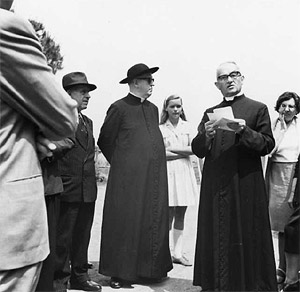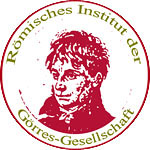Ludwig Voelkl (1959-1971)
The military priest Ludwig Voelkel was displaced to Rome during the Second World War and began his studies there at the Pontifical Institute for Christian Archaeology after the war. As a historian and architectural researcher of the Constantinian period, he made valuable contributions to the consolidation of the Institute in the post-war period.
Voelkl attended the Humanistic Grammar School in Burghausen. On 2 June 1917 he was called up for military service, only then received his school-leaving certificate and was wounded shortly afterwards at Verdun. After his release from French captivity on 10 February 1920, he studied at the Philosophical-Theological University in Passau and was ordained priest on 21 April 1924 in Passau. After pastoral work in Griesbach and since 16.04.1926 as cooperator at St. Paul in Passau. From the beginning of 1930 he was a part-time, and from April 1935 a full-time parish priest in Passau, from January 1937 an army parish priest in Würzburg and from August 1938 in Ludwigsburg.
During the Second World War he remained in military chaplaincy, from July 1941 as army pastor in Russia. He escaped to the West, was assigned to Albert Kesselring on 25 June 1943 and from 12 July 1943 was responsible for the supervision of the war chaplains in the German troops, with his headquarters in Frascati (since 26 September 1943 in Cività Castellana). In April 1945 he was briefly taken prisoner of war by the Americans and worked as a hospital priest in the Albano-Therme prisoner-of-war camp. The Americans transferred priests to the Vatican. So Voelkl came to Rome. Since 01.09.1948 he lived at the Anima, through the friendship with Engelbert Kirschbaum S.J. he moved to the Campo Santo Teutonico on 30.09.1950 as a scholarship holder of the Görres Society, where he acted as librarian and undertook the reorganisation and cataloguing of the Early Christian Medieval Museum, without completing it.
He began his studies at the Pontificio Istitiuto di Archeologia Cristiana in 1945, obtained his licence in June 1947 with a thesis on "The Orientation of the Constantinian Churches in the Orient and in the Occident" and was awarded his doctorate on 19.06.1950 with the thesis "Die konstantinischen Kirchenbauten im Orient und Okzident. A contribution to the question of whether and to what extent one is entitled to speak of a uniform building type in the Constantinian church buildings". Voelkl had been working at the Pontificio Istituto di Archeologia Cristiana since 1949 as Leo Kunibert Mohlberg's O.S.B. assistant for the Seminario storico per lo studio delle antichità cristiane; in 1950, Mohlberg hoped to appoint him as such to the liturgical institute to be founded at Sant'Anselmo. For his Subsidia, Voelkl promised him in 1951 the preparation of the texts for the Constantinian Churches in the West, in the Orient, for the Orientation of the Churches and for the terms "aula, ecclesia, basilica". At this time he also collaborated on the excavation publication of St. Peter's.
 Under the director of the Roman Institute of the Görres Society, Kirschbaum, Voelkl worked as secretary and, from 1953, as vice-director; from 12 December 1959 until 31 December 1971 he was director himself. In 1950 the Institute resumed its public lectures and excursions, and in 1954 the Römische Quartalschrift was published again. From 1957 onwards, Voelkl collected floor plans, records and reconstruction attempts of all early Christian church buildings in a photo and map library on behalf of the Görres Society. The collection remained unfinished; even a partial publication "Fotothek zur Topographie der frühchristlichen Kultbauten in Rom" (Photo library on the topography of early Christian cult buildings in Rome), which was promised in 1968, was not published. Together with Rector Schuchert, Voelkl also conducted successful Rome seminars for priests and religious education teachers at secondary schools from 1959 onwards, at which Kirschbaum and Kurt Körbel also gave lectures.
Under the director of the Roman Institute of the Görres Society, Kirschbaum, Voelkl worked as secretary and, from 1953, as vice-director; from 12 December 1959 until 31 December 1971 he was director himself. In 1950 the Institute resumed its public lectures and excursions, and in 1954 the Römische Quartalschrift was published again. From 1957 onwards, Voelkl collected floor plans, records and reconstruction attempts of all early Christian church buildings in a photo and map library on behalf of the Görres Society. The collection remained unfinished; even a partial publication "Fotothek zur Topographie der frühchristlichen Kultbauten in Rom" (Photo library on the topography of early Christian cult buildings in Rome), which was promised in 1968, was not published. Together with Rector Schuchert, Voelkl also conducted successful Rome seminars for priests and religious education teachers at secondary schools from 1959 onwards, at which Kirschbaum and Kurt Körbel also gave lectures.
Voelkl was particularly concerned with the scholarship holders and assistants of the Görres Society who lived at the college, including Walter Nikolaus Schumacher, Walter Kuhn and Otto Feld, whom he introduced to early Christian Rome through his guided tours. Voelkl regularly gave Saturday evening lectures ("Sabbatinen") and public lectures of the Historical Institute of the Görres Society on questions of early Christian art and architecture. He was responsible for the reorganisation of the early Christian collection of the Campo Santo Teutonico, which was shown at several exhibitions outside Italy from August 1962 to April 1964, and was completed in the new rooms at the beginning of 1966. Voelkl was in friendly contact with Erik Peterson and Hermine Speier, who worked in the Photothek of the German Archaeological Institute until 1934, had to quit there and was employed by the Vatican, for whose museums she built up the photographic archives. In 1970, Voelkl returned to his home in Passau and also lived with acquaintances in Konz on the Moselle.
His tomb is located on the Campo Santo Teutonico.
- Details
- Category: Former Directors
 Römisches Institut der Görres-Gesellschaft
Römisches Institut der Görres-Gesellschaft







